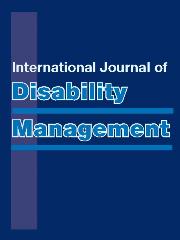Article contents
Workplace-Based Prevention and Rehabilitation Programs in Swedish Public Human Service Organisations
Published online by Cambridge University Press: 19 March 2014
Abstract
The purpose of this article is to contribute to knowledge about workplace-based prevention and rehabilitation programs by investigating effects on outcomes concerning employee health, psychosocial working conditions, sickness absence, sick-cases and rehabilitation indicators in 19 Swedish public human service workplaces including 311 individuals. Interviews with middle managers and an examination of documentation about prevention and rehabilitation interventions at the workplaces made it possible to group the workplaces in two workplace program groups — high versus low quality workplace-based prevention and rehabilitation programs. Statistical methods used were reliability tests, correlation analyses and t tests. Results indicate significant associations between changes in employee-judged stress and psychosocial working conditions, and changes in employee-judged health. The results concerning changes in employees’ health, stress and psychosocial working conditions (after workplace-based programs) showed significant differences between workplaces with high quality workplace-based programs compared with workplaces with low quality workplace-based programs, with the former having more favourable results. The study indicates that workplace-based prevention and rehabilitation programs with a broad change strategy and high levels of management and employee involvement can apply to small public sector workplaces.
Keywords
- Type
- Articles
- Information
- Copyright
- Copyright © The Author(s), published by Cambridge University Press on behalf of Australian Academic Press Pty Ltd 2014
References
- 2
- Cited by


